Why choosing the best digital adoption platform for your product is a make-or-break decision (and how to pick)

Dropping users in your product with no explanation is like owning a restaurant and expecting guests to walk into the kitchen to order: You'd never see the results you'd see if you gave customers just a little guidance.
While a restaurant might hire waiters, a software company can use digital adoption tools.
Your product is facing some usability challenges. Maybe users are struggling to see value quickly. Or maybe a bunch of features are lying by-the-wayside unused. Or your support team is inundated with “how do I do X in your product” questions. Or you just feel like engagement could be better
You Google around. What helps with this kind of usability problem in software products?
You see this buzzwordy-sounding phrase “digital adoption” show up in a bunch of places. And you discover there’s a whole category of tools — Digital Adoption Platforms, shocker — that purport to help with these exact problems.
So, you decide you need to give a digital adoption platform a try. You google things like “what digital adoption platform is easiest to set up” but you’re immediately drowning in marketing copy that universally promises results, ads that show off smiling happy (and engaged) users, and case studies.
Fear not — you are not alone in this battle for clarity!
Picking a digital adoption platform is tough! It is not about simply picking the solution with the most features, nor is it just a “choose the shiniest tool in the shed” game. It's about finding that perfect sidekick that complements your company's business while making your end-user experience significantly better.
But, that can be hard! From the get-go, you've got choices: some platforms are like that Swiss Army knife that can do digital adoption and a bunch more, while others are more focused on specific use cases. Some are uber flexible; others are opinionated in how they think users can be helped best (ok spoiler that is us). Plus there's that pesky confusion around employee digital adoption and user digital adoption — some tools do both, making it even harder to decipher what you really need or should choose!
We’ll help you sift through the flashy features and marketing fluff to nail down what really matters—ease of use, integrations, scalability, whether users actually like the stuff, and human support (ironic, we know).
Ready to be less dumbfounded?
Let’s dive into DAP land!
Difference between employee digital adoption and end-user digital adoption
One of the biggest misconceptions in the digital adoption space is that all digital adoption is the same. But the reality is that the term digital adoption gets totally interchanged and used for two extremely different processes.
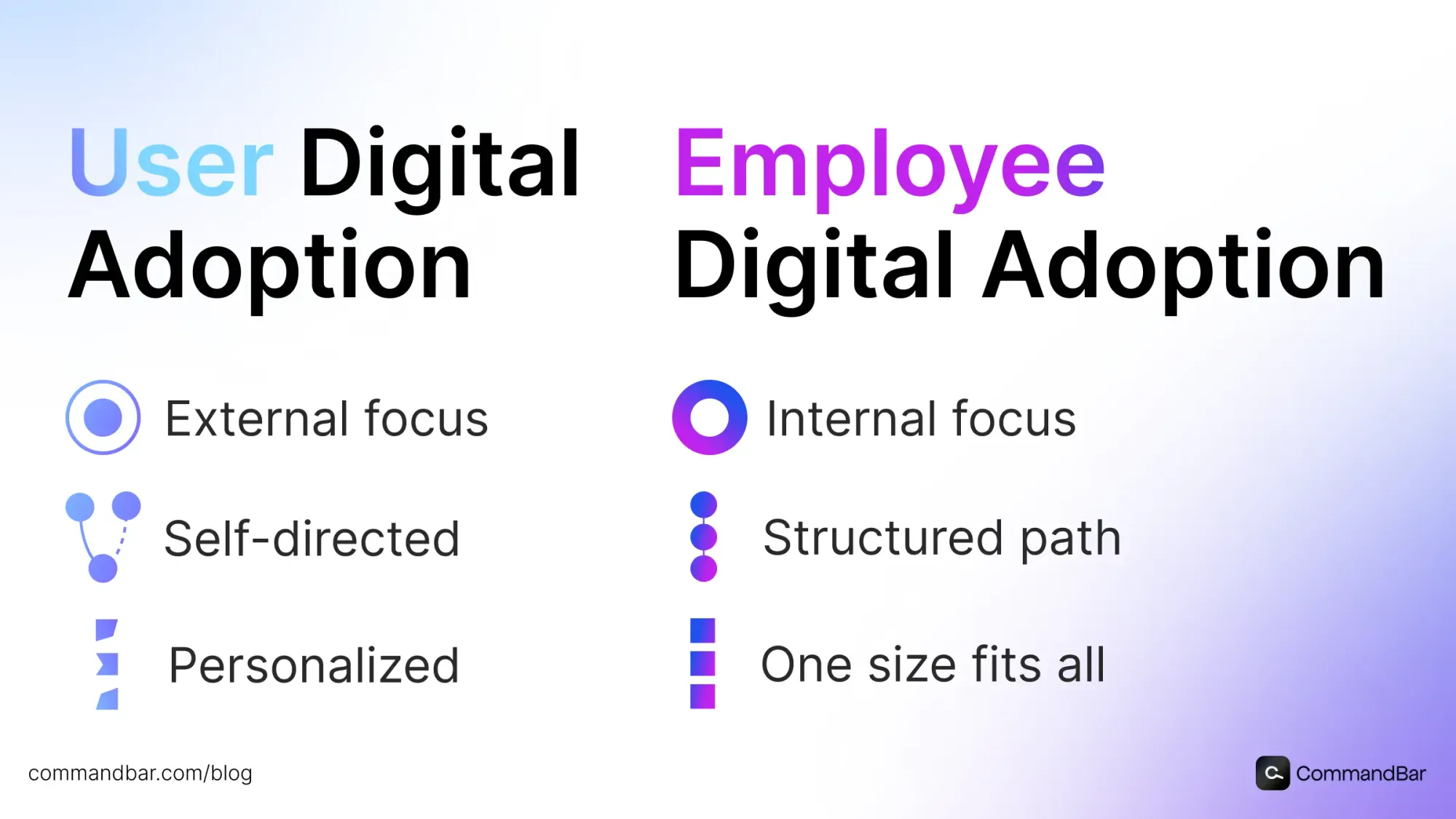
Internal employee adoption
Digital adoption is sometimes used to describe the process through which new software is implemented and taught to employees.
An example of this might be a new CRM that requires a decent amount of up-skilling. Your company buys a CRM and customizes it to fit its needs (maybe paying a consultant in the process). After that investment, employees need to learn how to properly use the CRM and the specific customizations the company set up. You might have different functions, like sales, marketing, and support all interacting in different areas of the CRM, and if you leave them to their own devices they can easily get confused or lost.
Integrating a time clock app can streamline employee time tracking, making it easier for businesses to manage hours worked and improve productivity
It can be helpful to have a digital adoption tool that helps with employee training, guides users through the initial set of actions, and generally smoothes the integration of that software into your company’s workflow.
In this case, the digital adoption platform is purchased by the buyer of the software, not the creator (or OEM) of the software. Note that internal employee adoption only makes sense in a B2B context.
User adoption
On the other side of the spectrum there is end user digital adoption, which allows software companies and builders (hopefully that’s you) to make their software work better for users, by improving the onboarding and overall in-app experience. Unlike a company doing an internal employee digital adoption program where it can be very standardized and structured and mandated, an end user digital adoption experience must not clash with the UX of the product it sits in, while also communicating and educating clearly.
With user adoption, you can’t rely on shipping long walkthroughs that can’t be dismissed because you can yell at all your colleagues - “you have to do this walkthrough”.
The experiences IT companies ship to end users using a digital adoption platform must be helpful and not annoying. Otherwise, users will just exit out of them and you’re back at square one. (You could still make them mandatory, but woe betides the software company that demands its users complete a bunch of long clunky pop-up tours.)
Understanding this distinction between these two very different digital adoption protocols is key toward words choosing the right platform for your needs. One software which is great for employee training could be the absolute wrong choice for your end users, and vice versa, while others offer solutions that can be used for both. And the key purchasing criteria differ both as well.
User assistance
In your googling for digital adoption stuff, you may encounter the term “user assistance” and “user assistance platform” thrown around. Wtf is that? Another acronym I have to worry about?
Yes, sorry. User assistance is a variant of digital adoption (dare we say, an evolution of digital adoption). The key difference between user assistance and digital adoption is that the latter focuses on the company’s goals (generating engagement) and the initial part of a user’s journey (the “adoption” part). User assistance, on the other hand, abides by the golden rule “treat users who you want to be treated”. We do this by focusing on experiences that users actually enjoy, that detect and react to user intent, and can be used through the user lifecycle.
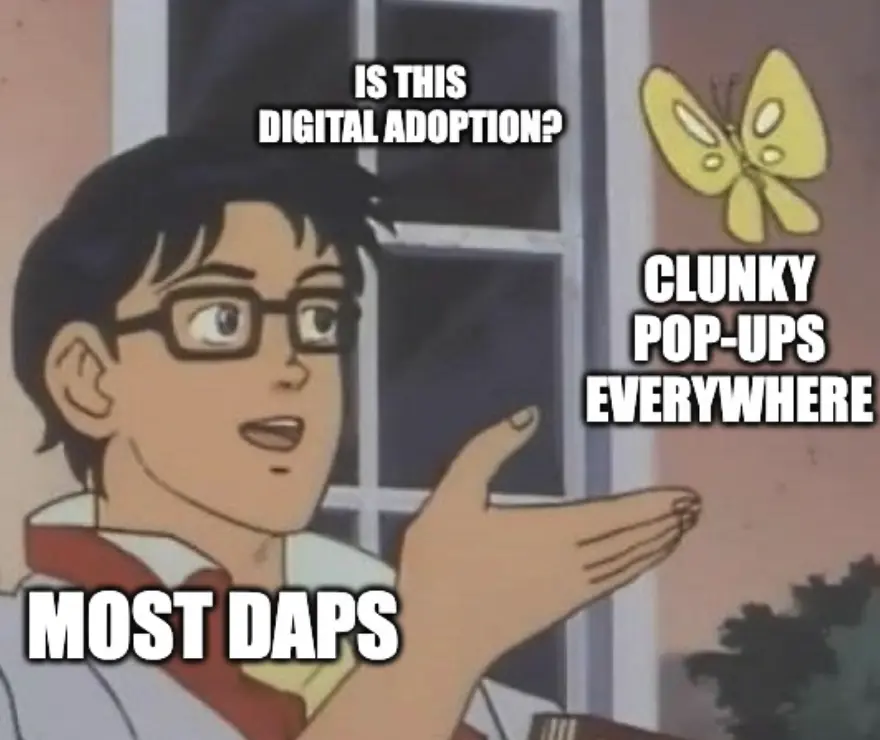
One example of the difference between digital adoption and user assistance in practice. You have a new feature you want to let your users know about. What do you do:
- Digital adoption approach: create an announcement (”We shipped something!”) and set it up to show to all users the next time they open your product.
- User assistance approach:
- Create a walkthrough that steps through the new feature. Share it with users who’ve used similar features in the past, or expressed interest in what the feature does through an interface like our in-app Copilot.
- When users ask about topics related to the feature in Copilot, give them the option of taking this walkthrough.
So, TLDR from this section. A UAP is technically a DAP, most all DAPs definitely are not UAPs.
Helping users maximize their experience also means providing them with AI-powered tooling, like an in-app Copilot to answer all their questions, that guides them to an answer quickly in a way that’s personalized to their question and their in-product experience.
What to look for in a digital adoption platform
DAPs are not one size fits all not only when it comes to internal use versus external, customer facing use, but also in their capabilities, usability and user friendliness, and ability to fit easily in a great with your software. The DAP that is right for a standalone mobile app vs. a multi-platform, enterprise software solution could be very different.
It’s a lot like fitting into a nice pair of gloves. The fancy ones with lots of colors and fur might not be necessary. Also, the vintage leather ones which have been around forever also might not be the best just because they're old and used a lot, in fact they may be exactly the opposite if you're looking for something else.
Sorry for the weird analogy, we just really like gloves.
Anyways, here’s a few things to consider when you’re evaluating which DAP to go with:
Integration with your product
The DAP should seamlessly integrate with your existing software stack without causing disruptions. That means a lightweight installation and support for however your app is deployed:
- Web-based application
- Desktop application
- Mobile web application
- Native mobile application
- An app deployed using a platform like Wix
Of course, if you only fall into one of these buckets, you only need to look for a DAP that supports your specific deployment model (and any you might consider adding in the future).
End-user impact
Every DAP has a slightly different set of experiences they let you build to achieve the goals of improving engagement, raising conversion, deflecting support tickets, all that good stuff. When you’re evaluating different options, you should ask yourself the question: for the experience I’m building in this DAP, would I as a user actually appreciate this experience? Or would I close out of it as quickly as possible?
Ease of use and customization
A user-friendly interface is vital, ensuring that non-technical team members can create and modify content without laborious training.
DAPs thrive when a variety of non-technical team members — customer success, product, marketing, even gasp sales — are empowered to create experiences to help users within the context of their team.
A good heuristic to use: could an intern or new hire set-up a survey or tooltip or other action item in their first week with minimal oversight?
The platform should offer customization options to match your company’s branding and aesthetic. If your brand is cool and trendy, you might not want a clunky and gray pop-up modal to be your only option.
Scalability
Scalability ensures that as your business grows, the DAP can handle increased demand. You don’t want to need to switch DAPs if you hit your lofty growth targets a year or two down the line.
If you’re a start-up, the best way to assess this is to look for a DAP that has a track record of working with fast-growing companies with lots of users. On the other end, if you’re a large corporation, you’ll want a DAP that has proven they can handle organizations and user bases of your size.
Analytics
Analytics provide insights into user behavior, helping identify areas of struggle or confusion. It’s no good collecting all that survey data and feedback if you don’t have dashboards and analysis tools on hand to break it down and turn it into actionable insight.
That said, a DAP is not a product analytics tool. There are many great product analytics tools out there, like Amplitude, Heap, Mixpanel, etc. Your DAP should provide analytics that allows your team to do two things:
- (1) optimize what they build in the DAP — for example, A/B test whether an announcement with Title A works better than Title B
- (2) assess the impact of the DAP on key metrics. That way you can answer the question — is this whole DAP business worth it?
Customer Support
Lastly, prompt and effective customer support from the DAP provider ensures any issues are quickly resolved, maintaining a smooth user experience and making sure your team doesn’t get slowed down.
Time to Value
All of the criteria set out above can be helpful when you're making a decision, but ultimately there's really one thing that most teams care about:
How quickly and effectively can I set this up, launch it, and have it start making a positive impact for our users and our goals?
This “time to value” concept is one of the best proxies for success for SaaS companies.
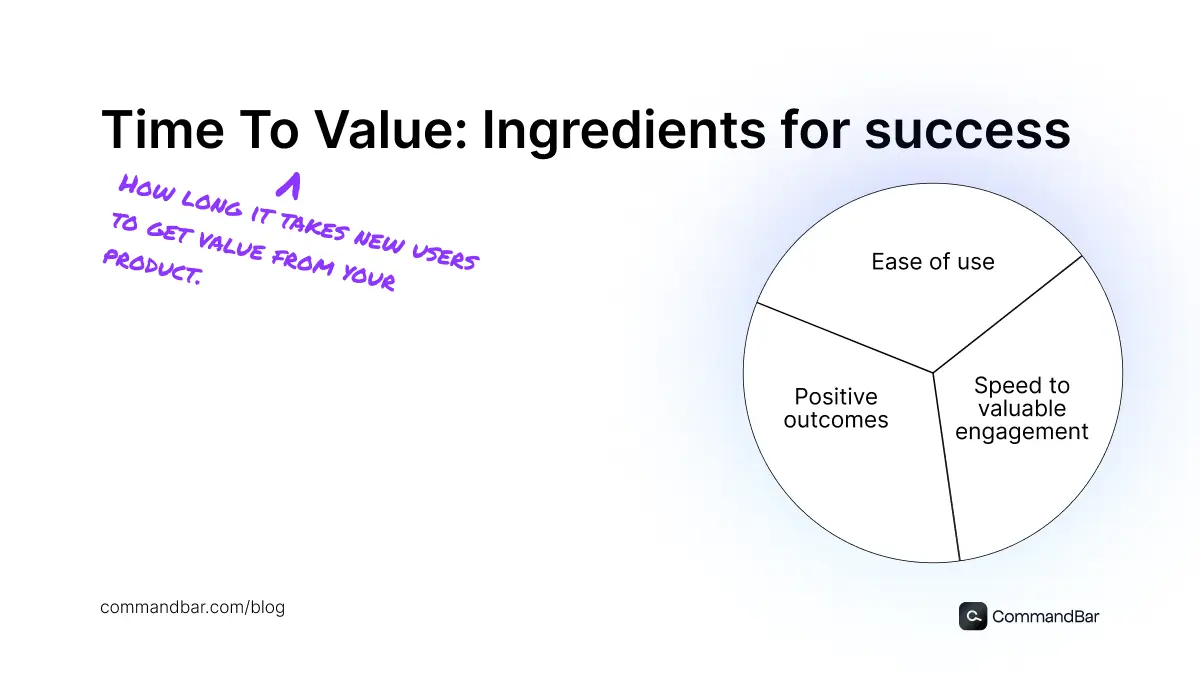
We’ve found that a lot of existing DAP tools are fairly clunky and require development resources. We kept this in mind when building our admin UI, which is completely idiot-proof and dare we say, not painful to use (we’re proud to lead the pack in ease of use).
Platform comparison
There’s dozens of tools that can help with different parts of digital adoption like onboarding or surveying, but there are only a few true comprehensive DAPs. With all the context and criteria set out above, let's now dive into some of the best platforms!
Company Overview and Ratings Table
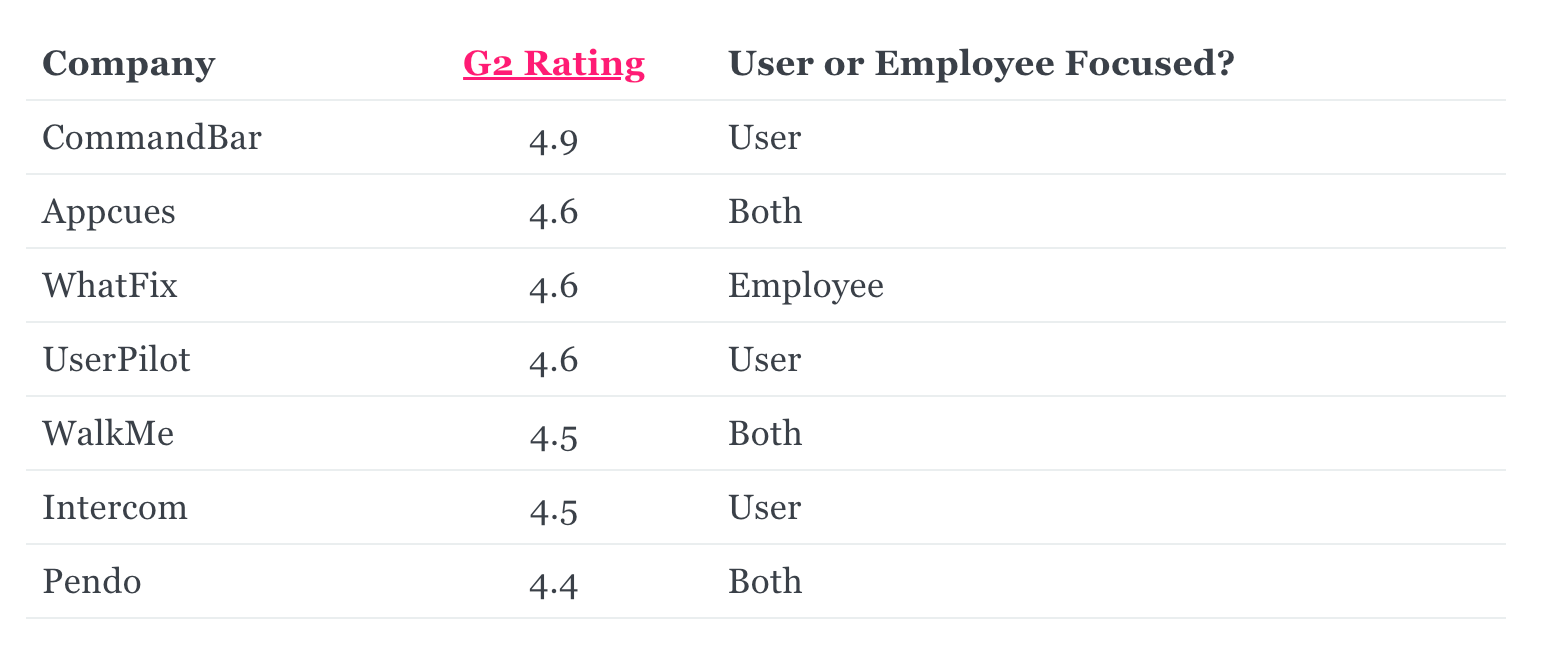
Command AI

Command AI identifies not as a DAP but as a User Assistance Platform (UAP) which we believe is the spiritual successor to DAPs and addresses the problems holding most DAPs back.
Command AI deprioritizes untargeted, interruptive pop-ups in favor of more native elements like lightweight nudges, a personalized in-app content center (HelpHub), and AI driven tools like Copilot that react to user intent.
With Command AI, your non-technical members can easily set up product experiences in minutes, with clear and simple targeting mechanisms and no code design tools. Plus, our Spotlight search bar and AI Copilot take your user experience to the next level. Whether they're searching for an answer to their question or for a blog article, they can quickly find the information they need.
More importantly, when you follow their threads and questions and conversations, you can begin to get deep insight into your users most salient concerns and problem areas, which can potentially be even more valuable than any survey feedback, NPS rating, or other data you collect through traditional methods.
Command AI’s winning edge:
- Amazing UI that makes building product experiences easy, even for non-technical folks
- Nudges
- Tooltips
- Product Tours
- All that good stuff
- AI powered Copilot chat for any app — empower your users to chat directly with your entire knowledge database and product
- Makes your product searchable with Spotlight Search
- And much, much more!
Pendo
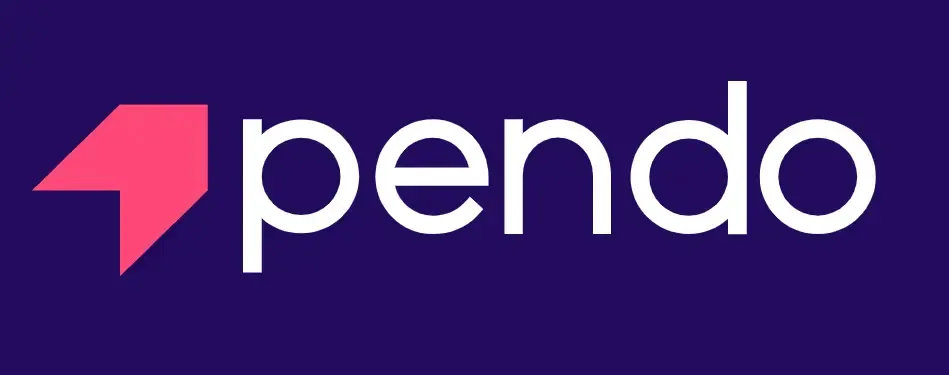
Pendo is a digital adoption platform that combines DAP functionality with a robust product analytics software, competing with the likes of Amplitude and Mixpanel. Pendo is best suited for companies looking to have one vendor for both DAP and analytics, and are willing to dedicate the developer hours needed to implement the platform.
Pendo’s DAP supports:
- In-app guidance and walkthroughs
- User onboarding and training
- Product analytics and insights
- Feedback and NPS collection
- A/B testing and experimentation
Pendo’s pricing is broken out into tiers:
- Free: Up to 500 MAU, single-app, and basic functionality and analytics.
- Starter: $7000/year: 2,000 MAU limit, multi-app, and access to premium features like NPS but it doesn't include advanced analytics or integrations.
- Growth: $18,000/year: 10,000 MAU limit, multi-app, advanced analytics, and integrations.
- Portfolio: $36,000/year: 25,000 MAU limit, multi-app, advanced analytics, and integrations.
- Feedback: $54,000/year: 50,000 MAU limit, multi-app, advanced analytics, and integrations.
- Adopt: $90,000/year: 100,000 MAU limit, multi-app, advanced analytics, and integrations.
WalkMe

WalkMe is another digital adoption platform. Actually the original digital adoption platform. WalkMe focuses on employee digital adoption but also has support for end-user adoption.
Primary use cases
- Multi-step product walkthroughs and guides
- On-demand support and help resources
- User analytics and insights
- Digital adoption planning and strategy
- A/B testing and experimentation
WalkMe for customer experience pricing: Custom, $9,000 to $50,000 a year.
Whatfix
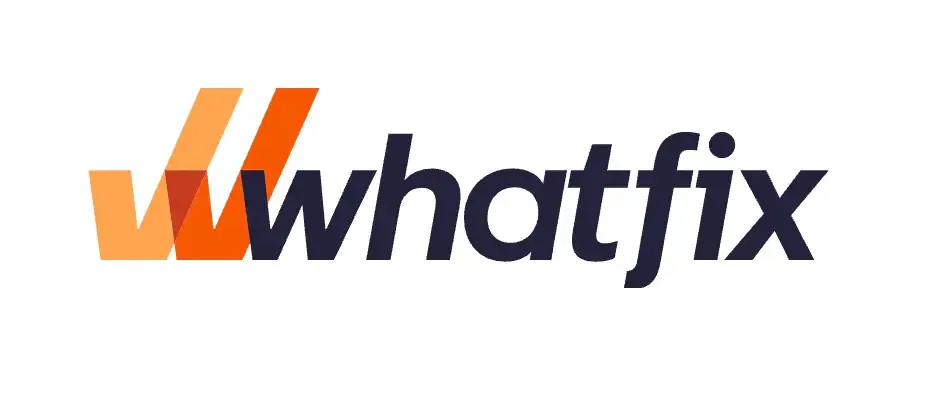
Whatfix is a digital adoption platform that helps businesses improve user adoption, increase product engagement, and drive revenue growth. Whatfix is good at building walkthroughs and user guides, but they focus on the employee adoption side of things.
Best use cases:
- Interactive walkthroughs and guides
- Self-service support and help resources
- User analytics and insights
- Digital adoption planning and strategy
- A/B testing and experimentation
WhatFix Pricing: Starts at $2,000
Intercom

Intercom is a customer communication platform that helps businesses build better relationships with their customers. Intercom helps companies increase communication speed and effectiveness with users. While not a strict DAP, they have some limited DAP functionality that is bundled along with their core customer support product. (The customer support product is very good, in our opinion — we use it here.) You can use Intercom for:
- Live chat
- Product tours and announcements
- Customer support ticketing
- Customer surveys and feedback
Intercom pricing is custom, but starts at $74/month and up.
Appcues

Appcues is a digital adoption platform whose stated goal is to help businesses onboard and engage their users. Appcues offers a variety of features, including:
- In-app product tours and announcements
- User onboarding and training
- User analytics and insights
- Feedback and NPS collection
- A/B testing and experimentation
Appcues pricing starts at $249/month and up.
Comprehensive Feature Review
Know exactly what you need feature-wise, but prefer others to do your work for you? Check out this handy table to cross-check your needs.
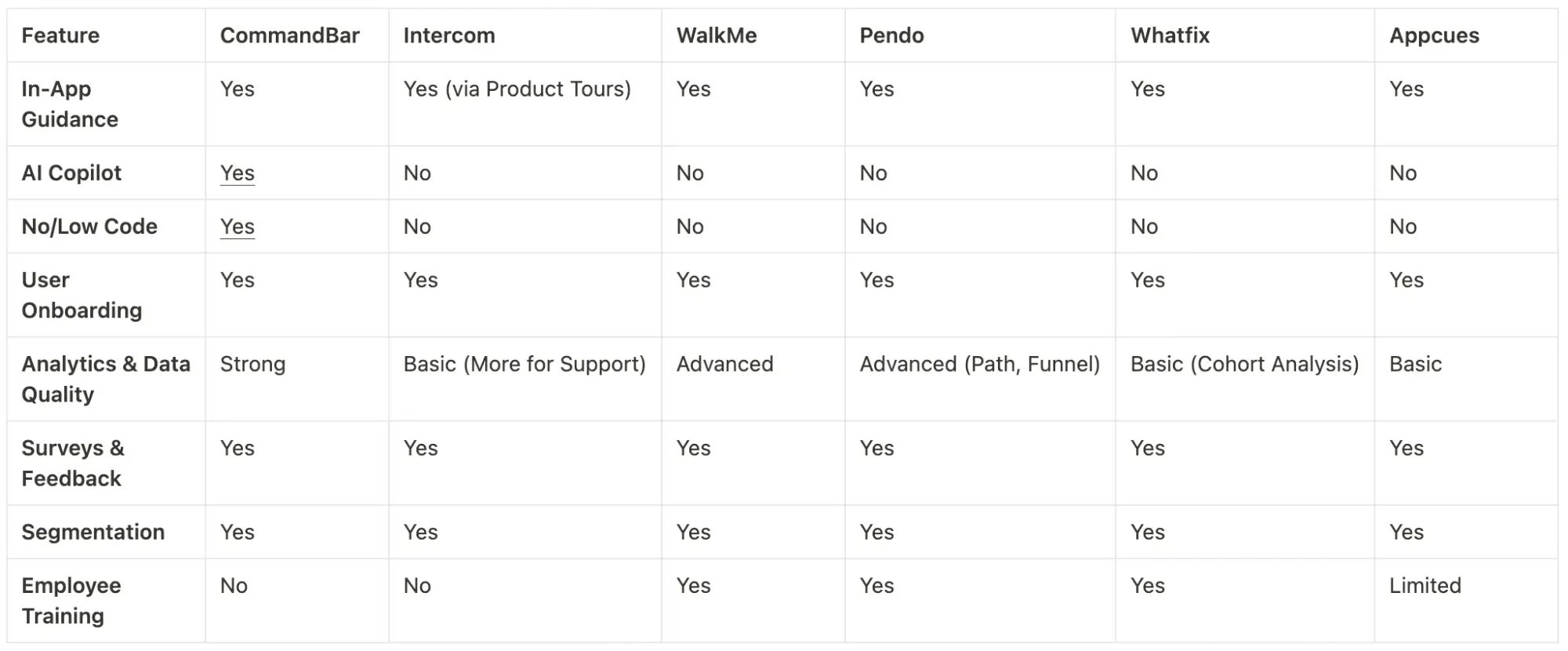
What’s the best DAP?
All of these DAPs have experience driving results for users, but the reality is that many have fallen behind when it comes to creating user friendly experiences.
Yes, they can all create pop-ups for you.
Yes they can all help you survey and collect feedback.
That’s the bare minimum for a DAP these days — table stakes.
But there’s more to DAP than just guidance, where you prompt users with pop-ups and nudges.
Go beyond just guidance with a user assistance platform (UAP, we taught you that already!) that is truly helpful and which has native channels like an AI Copilot that can unlock new UX insights.
If you're a user-focused product team that wants to create amazing experiences and improve your user activation, engagement, and retention, there's only one truth you need to know:
Treat your users like you would want to be treated — shun pop-ups, ship Command AI.
You can make an account and get going building nudges, tooltips, product tours, and surveys, as well as set up our AI Copilot that connects to all of your help documents, in under an hour.
Implementation is a huge blocker and slower of progress with all of these other platforms.
So if you're a product team that likes to move fast and work with an amazing UI, Command AI is a great choice (gets off soapbox).
Frequently asked questions about Digital Adoption Platforms
What exactly is a digital adoption platform (DAP)?
A digital adoption platform is your techy fairy godmother, turning the potentially pumpkin-like experience of learning new software into a smooth carriage ride. It's a suite of services and tools designed to help both employees and users not just use, but really get the most out of, a company's digital assets. Whether it's mastering a new CRM without breaking a sweat or navigating an app with ease, a DAP is there to guide, educate, and enhance the overall digital experience.
How does a DAP differ from traditional onboarding tools?
Unlike the one-size-fits-all approach of yesteryear's onboarding tools, today's DAPs are more like a Swiss Army knife, equipped for a variety of situations. They go beyond basic tutorials, offering personalized guidance, interactive assistance, and data-driven insights to support users at every interaction. Plus, they can dynamically adapt to different users' needs, making sure each person feels like the platform’s speaking their language.
Why is ease of use important when choosing a DAP?
Ease of use is the bread and butter of any DAP. If it's as complicated as assembling furniture without instructions, it's just going to gather digital dust. A good DAP should be intuitive, enabling your team to create, modify, and publish content without needing a PhD in software engineering—think more drag-and-drop, less code-and-swear.
Can a DAP help with both employee and end-user adoption?
Absolutely! While some DAPs are the life of the party in either employee or end-user settings, others are social butterflies that flit comfortably between both. The key is understanding whether a single platform can meet the distinct needs of your workforce and your customers, or if you're better off with a specialized wingman for each.
How important is scalability in a DAP?
Scalability in a DAP is as crucial as having room to grow in your favorite pair of jeans. You want a platform that can keep up with your company's growth spurt without losing its fit. A scalable DAP grows with your user base and features demand, ensuring that you're not shopping for a new solution when your business hits puberty and starts growing like a weed.
What role do analytics play in digital adoption?
Analytics in digital adoption are like having a GPS for your user journey. They track where your users are thriving and where they're taking wrong turns, providing insights that help you make better decisions. Without analytics, you're essentially road-tripping without a map, and nobody wants to end up at a dead end when they were aiming for the beach.
Is customer support a deal-breaker when selecting a DAP?
Think of great customer support like a trusty spare tire—it's essential when you hit a bump on the adoption highway. When issues pop up, you want a DAP provider that's as responsive as a roadside assistance crew, getting you back on track swiftly to maintain that smooth user experience. Skimp on support, and you might as well be driving with the check engine light on.
How does integration capability factor into choosing the right DAP?
A DAP should snap into your existing software stack like a Lego block, not like a square peg in a round hole. Integration capability means your DAP can play nice with your other tools, sharing data and triggering actions without the need for a tech translator. It’s all about creating a seamless workflow, where your digital tools complement each other in harmony.
What should I consider in terms of customization options for a DAP?
Customization is your chance to dress your DAP in your brand's colors, making it recognizable and cozy for users. It's like picking the perfect outfit for your software—it should reflect your style and speak your language. Plus, the ability to tweak and tune your DAP means you can ensure it fits your business like a glove, rather than wearing someone else's idea of fashion.
How do I determine the best DAP for my business's unique needs?
Determining the best DAP for your business is like choosing a new smartphone—it comes down to what you need most. Start by auditing your current tech pains, forecast your growth, and identify the unique quirks of your user base. Then, take DAPs for a test drive, focusing on ease of use, integration, scalability, analytics, and customer support that align with your business goals and user expectations.
